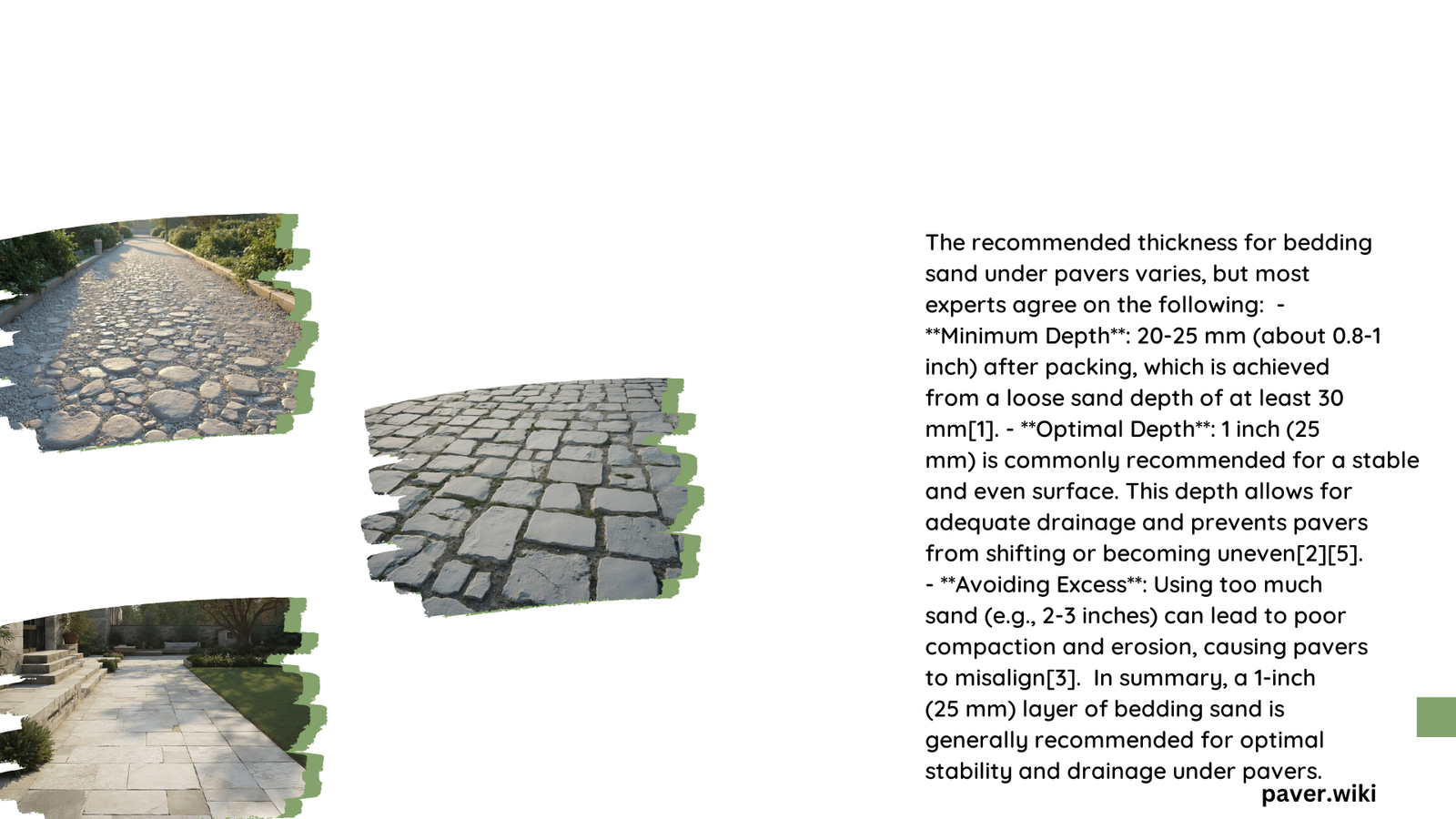Bedding sand thickness is crucial for proper paver installation. The standard depth for bedding sand under pavers is 1 inch (25 mm), with a tolerance of ±3/16 inch (3-4 mm). This uniform layer ensures even support and prevents excessive settlement. The thickness should not exceed 1.5 inches (40 mm) to maintain stability. Proper sand depth is essential for drainage, load distribution, and long-lasting paver installation.
What Is the Ideal Thickness for Bedding Sand Under Pavers?
The ideal thickness for bedding sand under pavers is 1 inch (25 mm). This depth provides optimal support and allows for proper drainage. Here’s a breakdown of the recommended measurements:
- Standard depth: 1 inch (25 mm)
- Tolerance: ±3/16 inch (3-4 mm)
- Maximum thickness: 1.5 inches (40 mm)
- Minimum thickness: 3/4 inch (19 mm)
It’s crucial to maintain a consistent depth across the entire installation area to ensure even support and prevent future settling issues.
Why Is the Correct Bedding Sand Thickness Important?

The correct bedding sand thickness is vital for several reasons:
- Even support: A uniform layer distributes weight evenly across the pavers.
- Proper drainage: The right thickness allows water to drain effectively.
- Stability: It prevents excessive movement or settling of pavers.
- Longevity: Correct thickness contributes to the overall durability of the installation.
- Aesthetics: It helps maintain a level surface for a polished look.
How Does Paver Size Affect Bedding Sand Thickness?
Interestingly, paver size does not typically affect bedding sand thickness. The standard 1-inch depth remains consistent regardless of paver dimensions. However, other factors may vary:
| Factor | Variation |
|---|---|
| Paver Size | No effect on bedding sand thickness |
| Base Course | May vary based on expected load |
| Soil Type | May affect base thickness, not sand layer |
While the bedding sand remains constant, the base course thickness might change:
- Residential driveways: 6-inch (150 mm) base
- Parking lots and residential streets: 8-inch (200 mm) base
What Are the Challenges in Maintaining Proper Bedding Sand Depth?
Maintaining the proper bedding sand depth can be challenging due to several factors:
- Compaction issues
- Drainage considerations
- Soil type impacts
- Weather conditions
- Installation techniques
Compaction Challenges
- Do not pre-compact the bedding sand
- Screed the sand to a level slightly higher than the final thickness
- Compact after laying pavers using a mechanical plate compactor
Drainage Considerations
- Use coarse-graded sand conforming to ASTM C33 standards
- Ensure proper slope of the base surface for water channeling
- Avoid fine sand that can impede drainage
What Type of Sand Is Best for Bedding Under Pavers?
The best sand for bedding under pavers should have the following characteristics:
- Washed and clean
- Non-plastic
- Free from deleterious or foreign matter
- Conforming to ASTM C33 gradations
- Coarse-grained for better drainage and support
Avoid using fine sand as it can lead to poor drainage and stability issues.
How to Achieve the Correct Bedding Sand Thickness?
To achieve the correct bedding sand thickness of 1 inch (25 mm), follow these steps:
- Use a mechanical screed for uniform distribution
- Ensure the sand is moist but not saturated (6-8% moisture content)
- Screed without compaction
- Check thickness with a depth gauge
- Adjust as necessary to maintain 1-inch depth across the installation area
What Are the Consequences of Incorrect Bedding Sand Thickness?
Incorrect bedding sand thickness can lead to various problems:
- Too thick (>1.5 inches):
- Excessive settling
- Uneven surface
- Poor interlock between pavers
- Too thin (<3/4 inch):
- Inadequate support
- Cracking or breaking of pavers
- Poor drainage
Maintaining the recommended 1-inch thickness is crucial for avoiding these issues and ensuring a long-lasting paver installation.
How Does Climate Affect Bedding Sand Thickness Requirements?
While bedding sand thickness remains constant at 1 inch (25 mm) regardless of climate, other aspects of the installation may be affected:
- Colder climates: May require increased base thickness
- Wet climates: Emphasis on proper drainage and sand selection
- Hot, dry climates: Attention to moisture retention in the sand layer
The key is to maintain the standard bedding sand thickness while adjusting other factors to suit local climate conditions.
What Are the Cost Implications of Bedding Sand Thickness?
The cost implications of bedding sand thickness are relatively minor compared to other aspects of paver installation. However, consider the following:
- Material costs: More sand for thicker layers
- Labor costs: Proper screeding and leveling take time
- Long-term costs: Incorrect thickness may lead to repairs
Investing in the correct 1-inch thickness and proper installation techniques can save money in the long run by preventing future issues.
By adhering to the recommended 1-inch (25 mm) thickness for bedding sand under pavers, you ensure a stable, durable, and aesthetically pleasing installation that will stand the test of time.
